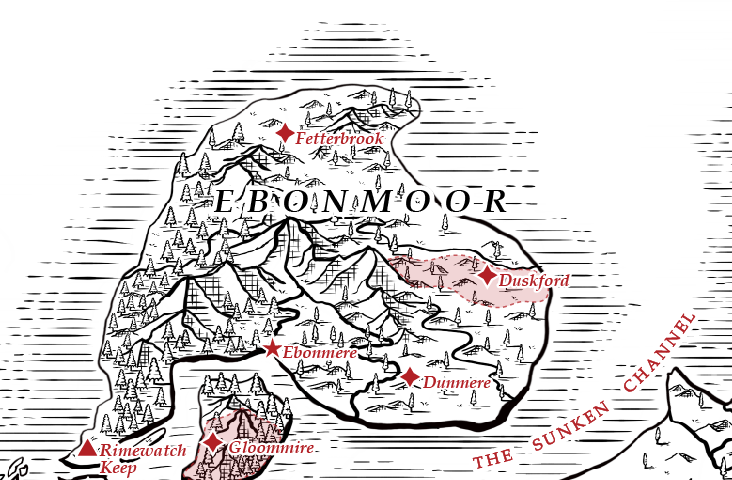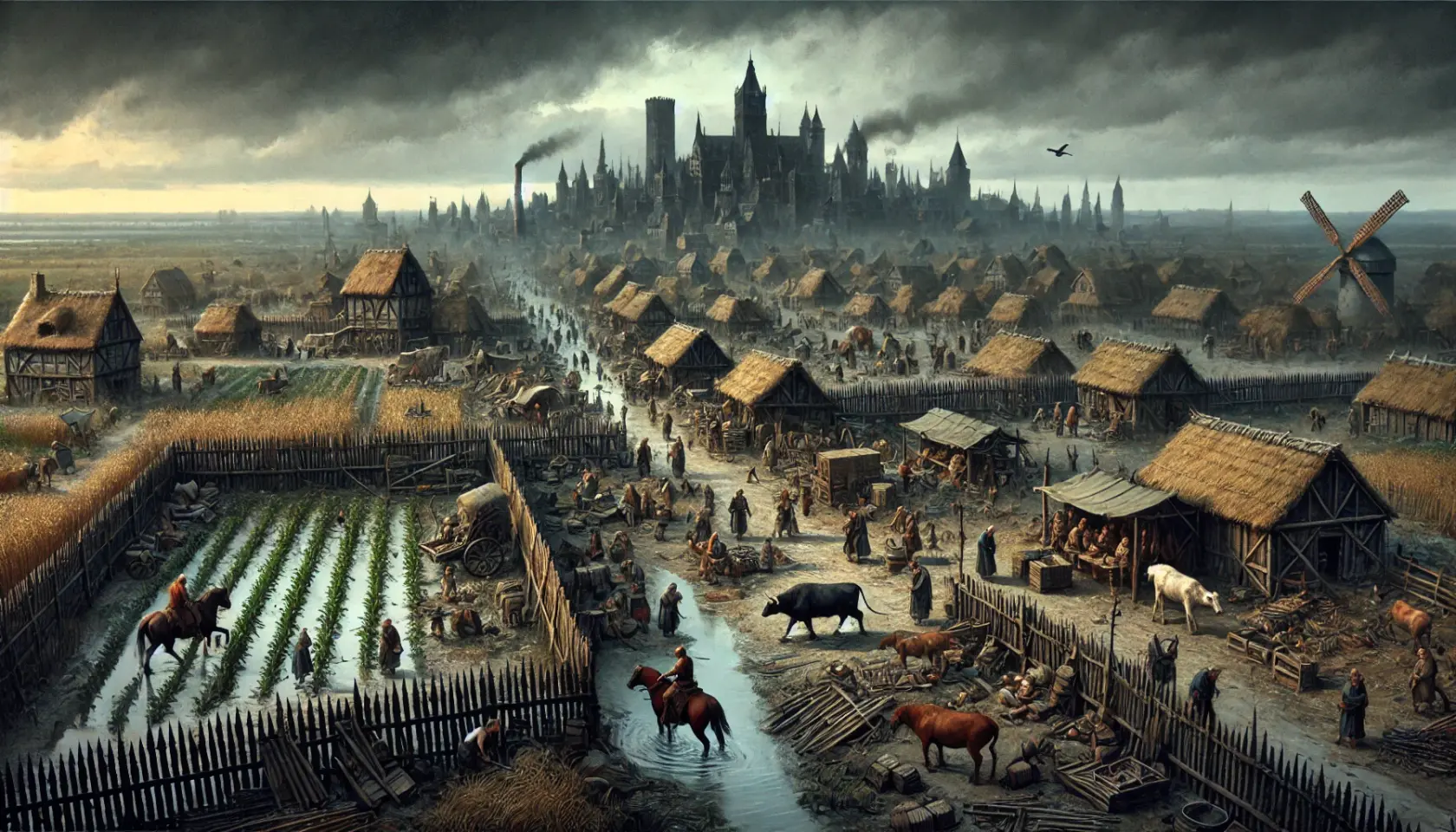Dunmere
The Dying Heart of Ebonmoor
We’ve tilled this land since our fathers' fathers walked it. We’ve raised cattle so strong they could weather the worst winters. But now? Now they rot on their feet, their eyes black as the Blight itself. The rivers still flow, the fields still stand, but I swear by the Old Ways—something in Dunmere has turned against us."
— Jorwel Kaelssen, cattleman
Dunmere was once the Breadbasket of Ebonmoor, a town built on the lifeblood of its fertile fields and strong rivers flowing from the Grimholt Peaks. It was a place of stability, prosperity, and abundance, where the cycles of planting, harvesting, and butchering dictated the rhythm of life rather than war or famine. Its golden wheat fields stretched as far as the eye could see, and its rolling pastures were thick with fattened cattle and sturdy hogs, raised for generations by families who took pride in their craft. The Kaelssen, Bronstad, and Hegerholm clans were among the most respected, known for breeding the healthiest livestock, their herds famous across Norvostra for the quality of their meat and resilience to harsh winters.
At the heart of Dunmere stood the Stonehall Market, a vast, open-air trading hub where farmers, butchers, and merchants bartered and sold their goods. The scent of freshly baked bread, roasted meats, and earthen spices filled the streets, and traders from as far as Mistvale and Blackvale made the journey just to secure the finest cuts of beef and pork. The town’s butchers were renowned, not just for their skill in carving meat but for their deep understanding of preservation, seasoning, and smoking techniques, ensuring that Dunmere’s meats were coveted even in lands beyond Faulmoor. During the autumn harvest festivals, the town would transform into a place of joyous revelry, with great feasts, music, and competitions where young ranchers showcased their prize-winning cattle and bakers competed for the title of the finest loaf.
Dunmere’s people were proud but welcoming, a mix of hardworking farmers, seasoned herders, and skilled tradesmen who valued tradition and community. Unlike the tense nobility of Valkenheim or the shadowed dealings of Greymire, Dunmere had no taste for intrigue or politics. It was a town of honest work and simple joys, where families passed down the knowledge of the land from one generation to the next. It was said that a man in Dunmere could be judged by the quality of his fields, the strength of his livestock, and the generosity of his table, and guests were always greeted with a hearty meal and a tankard of thick, honeyed ale.
Duskford, Dunmere’s sister town, served as its gateway to the wider world, with its bustling river docks sending barrels of salted pork, dried beef, and fresh grains to Blackvale and beyond. The two settlements thrived together, one feeding the region, the other ensuring its bounty reached those in need. Their connection was more than economic—it was personal. Many families had kin in both towns, and marriages between Dunmere’s herders and Duskford’s traders were common, strengthening the bond between them.
But when the Rotmire Blight took Duskford, that bond was severed in an instant.
Those who escaped fled to Dunmere, carrying nothing but desperation and grim determination. Yet, unlike the aimless refugees wandering other parts of Faulmoor, these people knew what was at stake. Many had once worked the fields or tended livestock, and instead of waiting for aid, they threw themselves into rebuilding Dunmere. Fields were expanded, irrigation systems improved, and new livestock enclosures erected in a desperate effort to secure food for Ebonmoor. They saw Dunmere as the last true stronghold of agriculture, the only hope for their people. But time was against them—while the crops flourished, the demand for food had tripled, stretching their resources to the limit.
Then came the sickness. It did not strike the people, but the livestock. At first, it was subtle—cattle grew restless, refusing to eat or sleep, their eyes wild with fever. Then the signs became clearer: veins blackened beneath their skin, their bodies bloated overnight, and some rotted from within, dissolving into a foul-smelling sludge that even carrion birds refused to touch. Dunmere’s butchers slaughtered thousands in an attempt to stop the spread, but the sickness persisted, creeping through the herds like an unseen shadow. No living person in Dunmere showed signs of the Blight, yet the symptoms mirrored it too closely to ignore. Fear gripped the town, for if the sickness could take the livestock, it was only a matter of time before it found its way into human flesh.
Rumors spread like wildfire. Some claimed the rivers from the Grimholt Peaks carried a hidden corruption, poisoning the land with every flood. Others believed the soil itself had turned, that the Blight had seeped into the earth and taken root. There were those who blamed the air, saying the Rotmire’s breath had begun to spread even where no undead walked. And then there were the voices of superstition and dread, whispering that this was punishment—that something older than the gods had cursed them for failing to save Duskford. No one knew the truth, but everyone understood one thing: if Dunmere’s livestock failed completely, there would be no saving Ebonmoor.
Recognizing Dunmere’s absolute importance, House Wilthorne and its vassals fortified the roads between Dunmere and Duskford, constructing multiple small forts and heavily guarded checkpoints along the key routes. Soldiers patrol the perimeter, searching for any sign of Blight encroachment or potential threats. These defensive measures have slowed travel, but they are necessary—if Dunmere falls, there is nowhere left to retreat. The fall of Dunmere would not only doom Ebonmoor but likely Faulmoor itself. Without its food supply, the region would collapse into chaos, leaving Ebonmoor defenseless and the survivors of Faulmoor with no means of sustaining themselves.
With its famed meat industry on the verge of collapse, Dunmere’s once-thriving butcheries now stand half-empty, their salted reserves dwindling dangerously fast. The town still produces grains and vegetables, but without livestock, they cannot sustain Ebonmoor’s needs. Food shortages have led to rising tensions—some have turned to smuggling, hoarding food for personal profit, while others grow increasingly hostile toward outsiders and traders seeking to take what little remains. Though Dunmere is still governed under Eadric Wilthorne, control has largely fallen to a council of farmers and butchers, led by Jorik Kaelssen, an aging but respected rancher. He fights to keep Dunmere stable, but the cracks are showing.
Dunmere is not lost—not yet—but time is running out. If the sickness cannot be stopped, if the food supply continues to dwindle, Ebonmoor will not survive another year. The people of Dunmere work with desperate urgency, but beneath their resolve lies a growing fear. They know the truth that no one dares speak aloud: it is only a matter of time.


